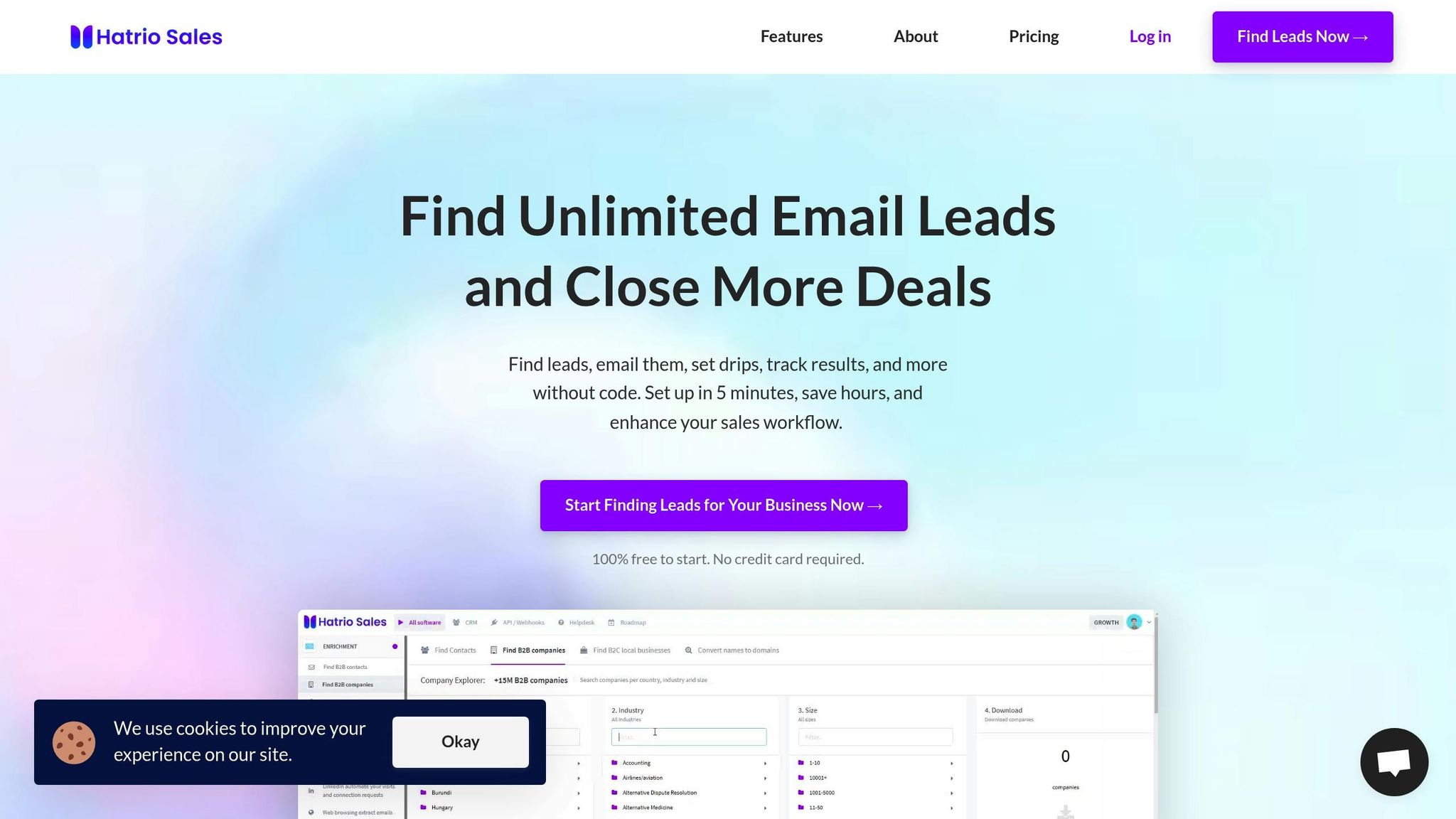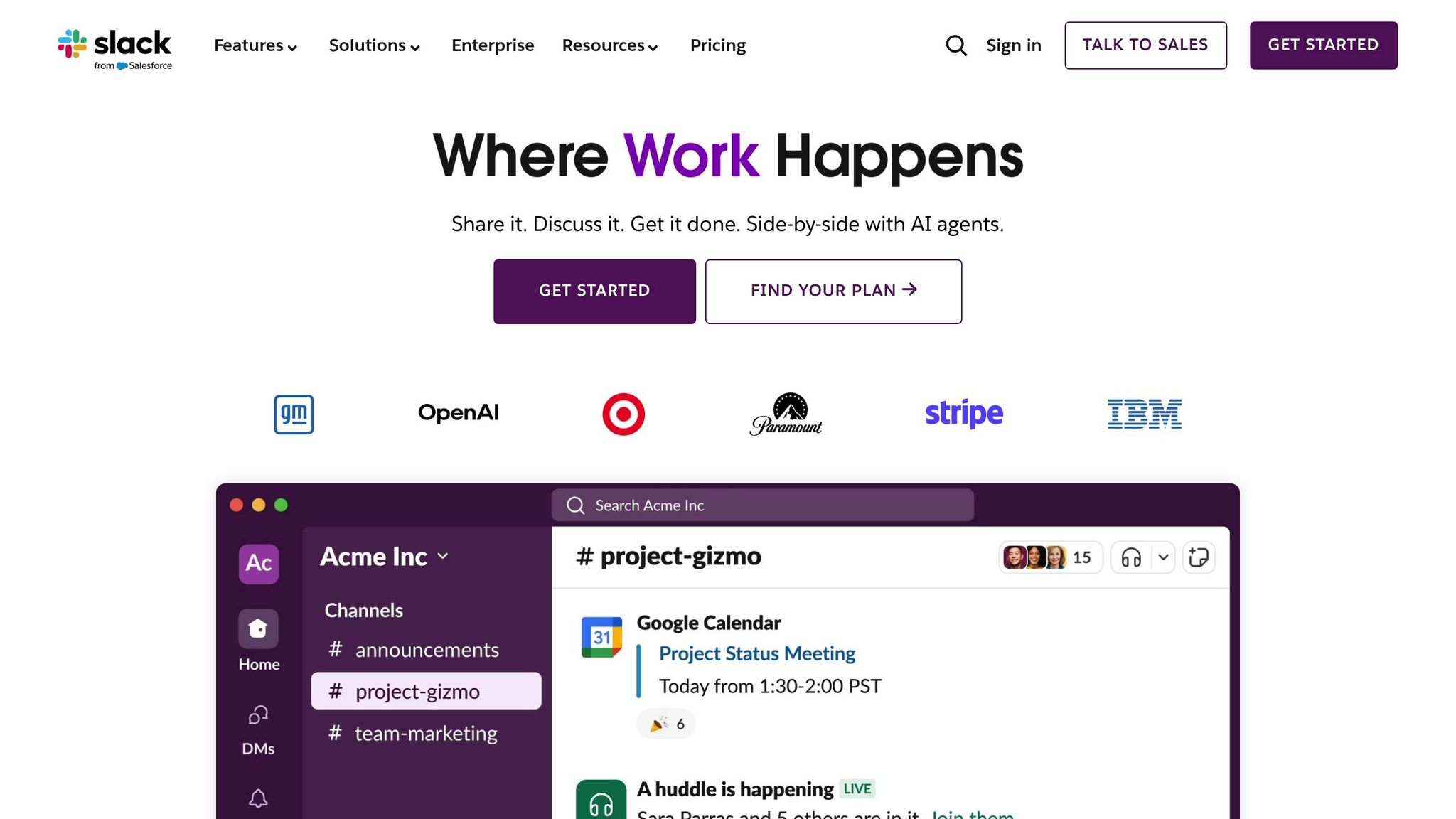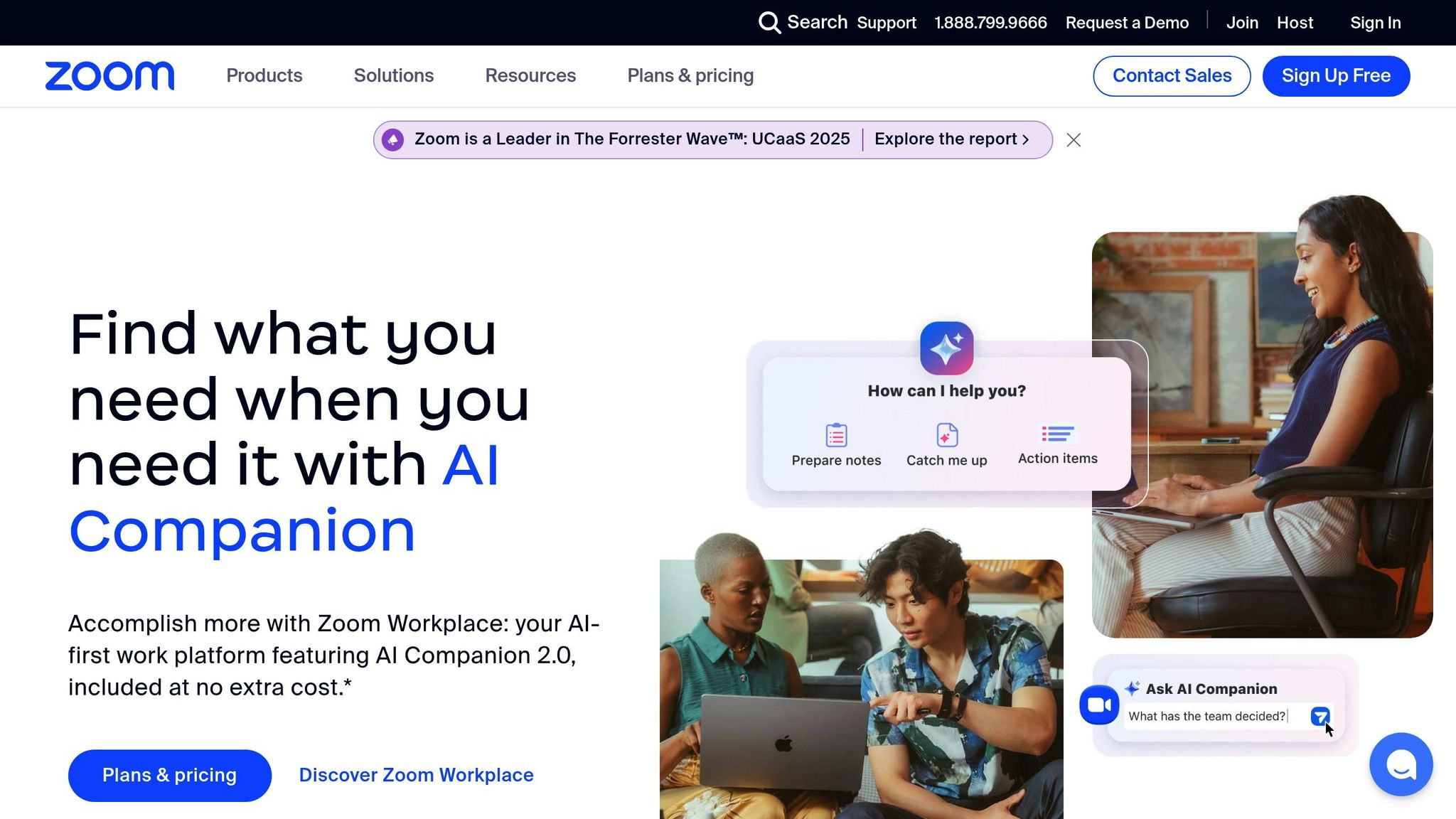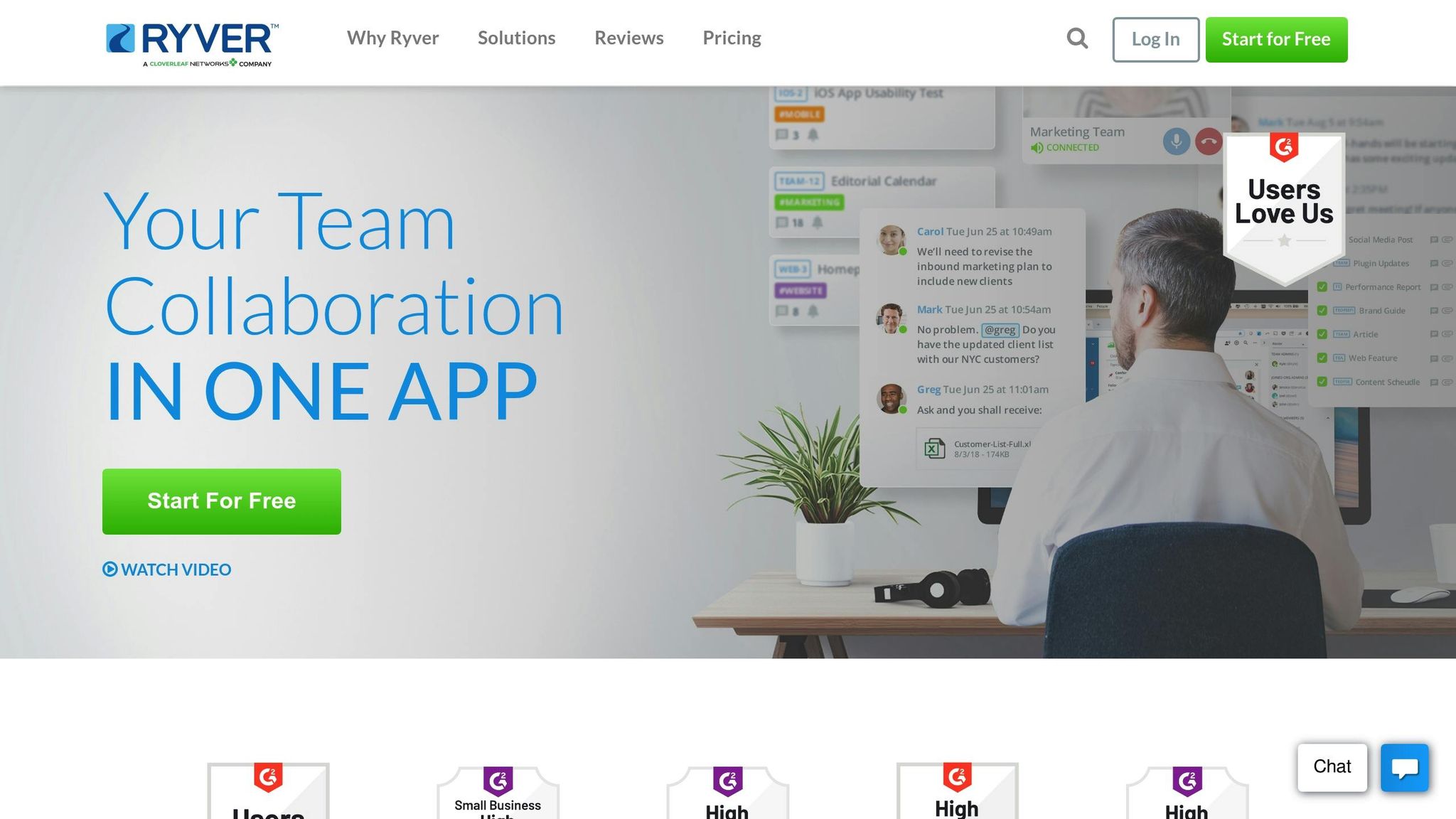Remote sales teams thrive with the right tools for communication, task management, and sales automation. Here's a quick rundown of the top tools to boost productivity and streamline workflows:
- Hatrio Sales: Combines CRM, LinkedIn prospecting, lead scoring, and sales automation. Ideal for managing end-to-end sales workflows.
- Slack: A messaging platform with channels, video calls, and app integrations. Great for quick communication and file sharing.
- Microsoft Teams: Centralizes chat, video conferencing, and file collaboration. Best for organizations already using Microsoft tools.
- Zoom: Known for video calls, webinars, and AI-powered meeting summaries. Perfect for virtual client interactions.
- Flock: Offers messaging, task management, and video calls at an affordable price. Useful for small teams.
- Ryver: Merges team chat and task management into a single platform. Suitable for simplifying communication and project workflows.
- Asana: Project management with task tracking, templates, and automation. Designed for organizing sales processes and cross-team collaboration.
Quick Comparison
| Tool | Key Features | Pricing | Best For |
|---|---|---|---|
| Hatrio Sales | CRM, lead scoring, automation | Contact for pricing | Complete sales workflow management |
| Slack | Messaging, file sharing, integrations | $8.75/user/month | Quick team communication |
| Microsoft Teams | Video calls, Office 365 integration | Free + paid plans | Microsoft ecosystem users |
| Zoom | Video conferencing, AI tools | Free + $149.90/year | Virtual meetings and webinars |
| Flock | Messaging, task management | $4.50/user/month | Budget-friendly collaboration |
| Ryver | Chat, task management | $49/month (12 users) | Simplifying communication and tasks |
| Asana | Project management, automation | $10.99/user/month | Organizing workflows and sales tracking |
Remote sales success depends on tools that align with your team's needs. Whether it's communication, task automation, or project management, these platforms can streamline operations and help close deals efficiently.
All the Tools you need to Sell From Anywhere
1. Hatrio Sales

Hatrio Sales is an all-in-one platform designed to tackle the unique challenges of remote sales teams. Unlike generic collaboration tools that focus solely on communication, this platform integrates every aspect of the sales process into one streamlined system. It's a game-changer for distributed teams managing intricate sales workflows.
Sales-specific functionalities
Hatrio Sales simplifies remote selling with features like automated lead generation, LinkedIn prospecting, and a built-in CRM that consolidates prospect information. Its sales-first design ensures that teams have the tools they need to prioritize and close deals efficiently.
Automated drip campaigns keep follow-ups consistent, no matter the time zones or schedules of team members. Lead enrichment and scoring tools help teams zero in on high-potential prospects, ensuring their time is spent on opportunities most likely to convert.
The deal-closing support feature provides structured workflows that guide prospects through the sales funnel. This ensures consistency across team members and minimizes the risk of missing critical steps, even when working independently. These features lay the groundwork for enhanced collaboration within sales teams.
Collaboration features for remote teams
Hatrio Sales offers real-time collaboration tools that keep everyone on the same page. Team members can assign tasks, share notes on prospect interactions, and track progress together, ensuring no details are overlooked - even when working across different locations and schedules.
Sales chatbots and shared lead databases maintain consistent communication with prospects while keeping internal teams aligned. Role-based access controls ensure sensitive information is secure, while still enabling cross-functional teamwork. Plus, these tools integrate seamlessly with existing software, making the transition smooth for any team.
Integration capabilities with other tools
Hatrio Sales shines when it comes to integrating with existing workflows. It connects with popular email clients for campaign management, syncs with calendar apps for scheduling, and integrates with third-party lead databases to enrich prospect data.
By reducing the need to juggle multiple tools, the platform eliminates the hassle of manual data transfers. Team members can work within a unified system that automatically updates and syncs information across their preferred software. This integration creates a smoother, more coordinated workflow for sales teams.
Support for team-based workflows
For distributed teams, Hatrio Sales offers robust workflow management tools. Team members can assign tasks, set automated reminders, and collaborate on deal stages, ensuring accountability and progress tracking are never compromised.
Sales managers benefit from centralized visibility into team activities, allowing them to monitor performance and address bottlenecks without micromanaging. Features like social proof widgets and online review management also help boost credibility by showcasing customer testimonials and ratings directly within outreach efforts - an invaluable tool for building trust in a remote sales environment.
2. Slack

Slack has become a go-to messaging platform for remote teams, with over 750,000 businesses using it daily for team communication, file sharing, and video calls. Its ability to keep conversations organized and accessible makes it an essential tool for remote sales teams, helping them stay on the same page when discussing deals and prospects.
Collaboration Features for Remote Teams
In remote sales, effective communication is non-negotiable. Slack’s channel-based structure, combined with features like Huddles (quick voice or video calls) and clips, keeps conversations about deals flowing smoothly, even across different time zones. Instead of sifting through endless email threads, teams can set up dedicated channels for specific projects or territories, keeping everything in one place.
To make things even easier, Slack Atlas offers customizable profiles that display each team member’s location, local time, and role. This added layer of transparency helps remote sales teams coordinate more efficiently across regions.
Sales-Specific Functionalities
Slack goes beyond basic communication by offering tools that directly support sales processes. For example, keyword notifications can alert team members when specific prospects, competitors, or deal-related terms are mentioned, ensuring timely action. Additionally, the Workflow Builder automates repetitive tasks, saving teams time - research shows it can boost efficiency by 28%.
Integration Capabilities with Other Tools
With over 2,600 app integrations, Slack connects seamlessly with popular CRMs like Salesforce, HubSpot, and Zoho, as well as project management tools like Asana, Trello, and Jira. It also integrates with video platforms like Zoom and Microsoft Teams Calls. These integrations allow sales teams to access critical account details right within Slack channels, simplifying operations and centralizing information.
Support for Team-Based Workflows
Slack Connect enables secure collaboration with external partners, clients, and vendors through dedicated channels. Threaded conversations and a searchable message history ensure that deal-related context is always at your fingertips, making it easy for managers to get up to speed. On top of that, Slack AI helps streamline workflows by providing channel summaries, daily updates, and automatic notes from Huddles.
Slack’s combination of communication tools, integrations, and workflow support makes it a powerful ally for remote sales teams.
3. Microsoft Teams

Microsoft Teams has become a go-to platform for remote sales teams, combining communication and collaboration tools into one seamless experience. With a whopping 145 million daily users as of March 2021, it serves as a central hub for staying connected, sharing data, and automating workflows - all critical for remote sales success.
Collaboration Features for Remote Teams
Microsoft Teams brings together chat, voice, and video calls into a single platform, making it easy for remote sales teams to stay in sync no matter where they are. Features like virtual meetings with screen sharing and recording help teams collaborate effectively, while its channel-based organization system allows for creating dedicated spaces for specific projects or topics. Need to get someone’s attention? The @mention feature ensures your message doesn’t get missed.
One standout example is Go Narrative, which saw a 40% boost in client satisfaction by using features like breakout rooms, whiteboarding, and transcription during meetings.
Sales-Specific Functionalities
For sales teams, Microsoft Teams takes things a step further with its integration with Dynamics 365 CRM. This allows users to manage customer information, schedule meetings, and even add customer records directly within Teams. Sales reps can join meetings from within Dynamics 365 and pin important customer data as tabs in Teams channels for quick access. Plus, the ability to chat or call directly from the CRM simplifies workflows and keeps everything in one place.
These sales-focused tools combine with Teams' broader functionality to create a seamless experience for managing customer relationships and team collaboration.
Integration Capabilities with Other Tools
One of Teams’ biggest strengths is its ability to integrate with the Microsoft 365 suite and over 1,000 other apps. This includes automation tools like Power Automate and data visualization through Power BI, which centralize sales data and streamline processes. For example, you can embed Power BI reports directly into Teams, ensuring vital sales metrics are always at your fingertips.
These integrations make it easy to connect your favorite tools and keep your team working efficiently.
Support for Team-Based Workflows
Microsoft Teams is built to support collaborative workflows, offering both open and private channels for group communication. Shared channels even allow you to bring in external contacts, making it easier to work with partners or prospects. The platform’s integration with Power Automate and its library of pre-configured templates (available in the Teams Store) help automate repetitive tasks, saving time and effort. With over 1,900 apps available, there’s no shortage of options to customize workflows.
For task management, Teams integrates with Planner, letting teams assign tasks, set deadlines, and track progress on sales goals - all within the platform. Combined with instant messaging, group chats, and video conferencing, these tools make it easy to collaborate and make decisions quickly, even in high-pressure sales environments.
4. Zoom

Zoom has become a cornerstone in video conferencing and unified communications, especially for remote sales teams. It offers far more than just video calls, earning recognition as a Leader in the 2022 Gartner® Magic Quadrant™ for Unified Communications as a Service (UCaaS).
Collaboration Features for Remote Teams
Zoom's platform combines multiple communication tools - video conferencing, team chat, phone, webinars, and conference rooms - into a single, streamlined experience. One standout feature is its AI Companion, which handles meeting transcriptions, summaries, and action item tracking. Other tools like Zoom Whiteboard enable virtual brainstorming, while Zoom Clips allow users to share video messages and screen recordings. The platform even supports multi-language and translated captions, making it easier for global teams to stay connected.
"With Zoom, we communicate better and work more efficiently. We're much more agile." – Frank Menne, Managing Director, OctoGate IT Security Systems GmbH
Zoom's focus on seamless communication extends to tools designed specifically for sales teams.
Sales-Specific Functionalities
Zoom provides several features tailored to meet the needs of sales professionals. The Auto Dialer helps sales reps connect with more prospects in less time, while the Zoom Revenue Accelerator uses AI to analyze customer interactions, offering insights like call summaries and performance metrics. Profile cards make it easy to see team members' working hours and locations, while scheduling tools simplify setting up meetings with external clients. Additionally, Zoom Webinars are perfect for hosting product demonstrations and online sales presentations.
These tools integrate effortlessly with other applications, enhancing productivity even further.
Integration Capabilities with Other Tools
Zoom's App Marketplace features over 1,500 apps, ensuring compatibility with the tools your team already relies on. For instance, its integration with Salesforce embeds communication tools directly into your CRM. It also works seamlessly with Microsoft Teams and Google Workspace, making it easy to manage schedules and share information. For automation enthusiasts, Zoom Workflow Automation lets users create workflows that connect Zoom services with third-party apps. Looking ahead, Zoom plans to integrate its AI-first contact center with Salesforce Service Cloud Voice by Summer 2025, enabling customer support agents to work from anywhere with just a browser and headset.
Support for Team-Based Workflows
Zoom also shines in supporting team-based workflows. After meetings, the AI Companion can automatically organize summaries into a dedicated Zoom doc and share them in a Team Chat channel, ensuring smooth follow-ups. Virtual whiteboards further enhance collaboration, allowing teams to plan projects and brainstorm effectively.
"When I'm working with our leadership team, we use Zoom Whiteboard so that we can pop it up in the room during a meeting, or on our screens at home when one of us is remote. We can still be looking at the same thing, collaborating, and keeping that work going, which has been huge." – Jeremy Raleigh, Software Project Manager, TechSmith
With its comprehensive suite of features, Zoom continues to be an essential tool for remote sales teams looking to stay connected and productive.
sbb-itb-b22f30c
5. Flock

Flock is a team collaboration platform that brings together messaging, video conferencing, and productivity tools in one place. For remote sales teams, it acts as a central hub where communication, task management, and file sharing come together effortlessly.
Collaboration Features for Remote Teams
Flock stands out with its customizable channels, allowing teams to organize conversations by topics, accounts, or projects. It offers instant messaging, video calls with screen sharing (up to 20 participants), and a powerful search tool to quickly find messages, files, or links. Its productivity tools - like Shared To-Dos, Polls, Note Sharing, and Reminders - help teams stay on track and ensure important documents reach the right people. These features make it easier for remote teams to communicate and manage tasks effectively.
"The most critical thing is getting information to the right person quickly. That's what Flock does."
- Carlos T, Technical Support Manager, Ituran
Some businesses have even cut down email traffic by as much as 75%, showcasing how Flock simplifies communication workflows.
Sales-Specific Functionalities
Flock goes beyond basic collaboration by addressing specific sales needs. Its CRM integration notifies team members as soon as leads qualify, keeping everyone in the loop. Dedicated channels can be set up to share campaign updates, track deal progress, and maintain focus on closing opportunities. Teams can also create channels for specific accounts or deals, assigning tasks with deadlines to ensure follow-ups don’t slip through the cracks.
"Our sales channel has an integration that tells us whenever a client has paid, so it's quite a celebration every time that happens - we close a deal!"
- Shekhar Kapoor, Vice President, Sales, ConvertCart
Integration Capabilities with Other Tools
Flock works seamlessly with over 50 other tools, helping teams manage their workflows without constantly switching apps. For instance, Google Calendar integration ensures schedules are well-organized and deadlines aren’t missed. Tools like Google Drive, Dropbox, and Box make sharing sales materials simple and efficient. Flock also connects with IFTTT to send notifications about new leads, status updates, or successful deals. Social media integrations keep teams informed about prospect interactions, adding another layer of connectivity.
Support for Team-Based Workflows
Flock is tailored for collaborative sales efforts. Teams can create spaces to address client questions, share sales forecasts, and celebrate wins together. Shared To-Dos help manage tasks and timelines, while in-chat polls make quick decision-making easier. Team Notes, whether private or shared, allow for fast information capture and support file attachments for added convenience.
"Flock is our virtual office - a central hub where everyone can work together, drive through action, and, ultimately, succeed as a team."
- Hillan Klein, COO, Namecheap
Pricing starts at $4.50 per user per month (billed annually), with a 30-day free trial available.
6. Ryver

Ryver stands out as a tool that combines messaging and task management into one platform, making it a great choice for remote sales teams. Instead of juggling separate apps for communication and project management, Ryver allows teams to seamlessly turn conversations into actionable tasks, streamlining workflows and keeping everything in one place.
Collaboration Features for Remote Teams
Ryver organizes conversations into forums, groups, or direct messages, giving teams flexibility in how they communicate. Forums are ideal for company-wide announcements or open discussions, while groups create private spaces for team members to work on specific deals or accounts. The platform supports unlimited chat, voice and video calls (up to five participants), and screen sharing, making collaboration effortless.
Need to find an old conversation or file? Ryver’s search feature makes it easy to locate past discussions, shared files, or key details. File sharing is built directly into chats and tasks, so teams can work on sales materials, proposals, or client documents without leaving the app. On top of these communication tools, Ryver integrates task management to keep sales processes moving smoothly.
"For the first time since starting the company, I feel like we're actually communicating and information is all in one place... I can't recommend Ryver enough."
- Chris Drake, Founder and CTO, Armor
Some companies report cutting internal email use by over 75% after adopting Ryver, highlighting how it simplifies communication workflows.
Sales-Specific Functionalities
Ryver takes collaboration a step further by letting teams instantly convert discussions into sales tasks. For example, when a team is talking about a lead or deal, they can immediately create a task with due dates, assignments, and progress tracking. This ensures follow-ups happen on time and everyone knows their responsibilities.
Dedicated channels for specific accounts or deals help teams stay organized, keeping updates and progress tracking in one place without cluttering general chats. Plus, with Zapier integration, teams can receive real-time notifications for new sales leads, ensuring no opportunity slips through the cracks.
Integration Capabilities with Other Tools
Ryver connects with over 2,000 apps via Zapier and offers native integrations with tools like Google Drive, Dropbox, and Box.com for smooth file sharing. For teams with unique workflows, APIs and webhooks allow for custom automation tailored to specific sales processes.
Ryver’s "Watches" feature (formerly News Streaming) is another standout. It lets teams monitor social media mentions, news articles, and RSS feeds directly within the platform, keeping everyone informed about relevant online activity.
Support for Team-Based Workflows
Ryver’s task management goes beyond simple to-do lists. Teams can create detailed tasks with checklists, tags, and assignments, organizing them on both personal and team task boards. Customizable notifications ensure team members receive important alerts without being overwhelmed.
"Ryver has quickly replaced Slack and has gone on to become the most popular tool for communicating at Efficio, with over 300 users and counting."
- Sam Thomas, Head of Data Science, Efficio
Pricing starts at $49 per month for up to 12 users.
7. Asana

Asana offers powerful project management tools that make remote sales collaboration more effective by organizing workflows and tracking progress on deals and campaigns.
Collaboration Features for Remote Teams
Asana provides multiple views - List, Board, Calendar, and Timeline - that allow teams to create tasks with assignees, set start and due dates, and organize them into sections that reflect sales stages or account structures. The platform also supports task-based messaging, file attachments, and notifications, helping to minimize email clutter and ensure everyone stays informed. These views serve as the backbone for creating sales-focused workflows.
"Asana has been extra helpful as we've all gone remote and quickly pivoted focus. Everyone can stay up to date on contributions, stakeholder approvals, and timelines which has transformed how we work. We're now more collaborative, accountable, and efficient in hitting our deadlines."
- Joe LaGrutta, Manager, Senior Strategy & Operations at 15Five
Sales-Specific Functionalities
Asana simplifies sales processes with templates designed for planning and pipeline management. These templates help teams establish clear workflows and align individual sales goals with broader objectives like pipeline generation, win rates, and revenue targets. Custom fields allow teams to track critical pipeline data, such as assigned account executives, deal sizes, statuses, and estimated close dates, improving both forecasting and visibility. Additionally, automation features handle repetitive tasks, like transitioning deals from prospecting to closing, saving time and reducing manual effort.
Integration Capabilities with Other Tools
Integrations play a big role in Asana's functionality. The platform connects with over 260 applications, including popular tools like Salesforce, Zendesk, Freshdesk, Google Workspace, and Microsoft Outlook. For example, its Salesforce integration automates workflows and tracks customer journeys, enhancing collaboration between sales and post-sales teams. Integrations with HubSpot and Mailchimp let teams keep track of deal context and monitor campaign metrics directly within Asana.
"We want to go deep with our clients while maintaining a unified, consistent approach. Asana helps us do that. We connect it to Zendesk, Zoom, Slack, and our own platform, making Asana the source of truth we can count on to get stuff done and bring us together across teams."
- Kevin Weiss, VP of Client Success, Retail Media, Skai
Support for Team-Based Workflows
Asana acts as a central hub where teams can customize workflows to suit their needs. It helps establish clear communication guidelines, streamline recurring tasks, and define responsibilities to avoid bottlenecks. Teams can also build knowledge bases within Asana projects, ensuring that account histories, client preferences, and deal details are easily accessible across the organization.
"The way we use Asana is intended to give everyone the same visibility into every partner. If we sign a company and a year down the road there's a problem, the furniture buyer can go into Asana and see the history of that partnership. They can see the date they signed, when they went live, their sales contracts, any discussions."
- Leslie Killinger, Business Development Manager, Overstock
Research from IDC shows that teams using Asana achieve a 54% faster execution of business processes, deliver 57% more projects on time, and see a 14% boost in client/customer satisfaction. With its tailored tools and integrations, Asana keeps remote sales teams aligned, efficient, and productive, making it a standout choice among collaboration platforms.
Feature Comparison Table
Selecting the best remote sales collaboration tool depends on your team's unique requirements, budget, and the tools you already use. Here's a quick look at some popular options, highlighting their key features, pricing, ideal use cases, and primary benefits:
| Tool | Key Features | Pricing (USD) | Ideal For | Main Advantages |
|---|---|---|---|---|
| Hatrio Sales | CRM system, LinkedIn prospecting, lead generation, email and drip campaigns, sales automation, lead scoring, chatbots | Contact for pricing | Comprehensive sales workflow automation and lead management | Complete sales suite with powerful automation features |
| Slack | Team messaging, file sharing, video calls, app integrations, channels | $8.75 per user/month | Quick team communication and seamless file sharing | Easy communication with strong app integration |
| Microsoft Teams | Video conferencing, chat, file collaboration, Office 365 integration | Free version available; Business Premium for advanced features | Organizations using Microsoft tools | Deep integration with Office and strong security features |
| Zoom | Video conferencing, webinars, phone calls, screen sharing, recording | Free (40-minute limit); Pro at $149.90 per user/year | Video meetings and client presentations | Excellent video quality and conferencing capabilities |
| Flock | Team messaging, task management, video calls, file sharing, channels | $4.50 per user/month (billed annually) | Centralized communication with task management | Budget-friendly with built-in productivity tools |
| Ryver | Team chat, task management, file sharing, voice/video calls | Contact for pricing | Small to medium teams needing combined communication and project management | Merges messaging and task management into one platform |
| Asana | Project management, task tracking, multiple views (List, Board, Calendar), automation, custom fields | $10.99 per user/month | Organizing sales processes and cross-department collaboration | Advanced project management with flexible collaboration |
This table provides a straightforward way to compare tools based on their features and pricing. For teams focused on communication, Slack and Microsoft Teams are strong options. If video conferencing is a priority, Zoom stands out. Asana is ideal for managing projects and workflows, while Flock offers an affordable solution with productivity tools. For comprehensive sales automation, Hatrio Sales delivers an all-in-one platform.
Ultimately, your choice should align with your team's specific needs, whether it's seamless communication, task management, or advanced sales automation.
Conclusion
Picking the right collaboration tools can make or break remote sales success. The numbers don’t lie: 86% of employees and executives cite poor collaboration as a top reason for workplace failures. When your team is spread across different locations and time zones, having the right technology isn’t just helpful - it’s essential.
Tools like Hatrio Sales for automation, Slack for communication, and Asana for project management each cater to specific workflow needs. Companies that focus on fostering a collaborative culture and adopt advanced communication platforms are five times more likely to perform at a high level. They also report up to a 25% boost in employee engagement. So, what should you keep in mind when choosing these tools?
First, look for tools that are easy to use. Intuitive platforms that require little training are a must. Next, prioritize integration capabilities - over 70% of organizations value tools that seamlessly connect with their existing systems. And don’t overlook security, which is a top concern for 80% of businesses when it comes to safeguarding sensitive project data.
Yes, these tools can be a significant investment - on average, businesses spend $3,894 per sales rep annually on sales technology. But the payoff is clear: streamlined workflows, faster issue resolution (35% quicker), and improved decision-making (30% faster). When the right tools work together seamlessly, the results speak for themselves.
Start by assessing your team’s needs, budget, and current tech stack. Test your top choices, gather feedback, and focus on the tools that truly enhance productivity and help close deals. Investing in the right collaboration tools is a step toward building a more connected, efficient remote sales team that consistently hits - and exceeds - its targets.
FAQs
How can I choose the right remote sales collaboration tool for my team?
To find the right remote sales collaboration tool for your team, start by assessing key factors like your team’s size, the specific needs of your industry, and how your current workflows operate. Focus on tools that provide real-time communication, integrate smoothly with your existing systems, and have an easy-to-use interface to keep things running smoothly and efficiently.
Key features to look for include sales automation, lead management, and collaboration tools that align with your team’s objectives. Make sure the tool can adapt to your team’s unique processes and has the flexibility to grow alongside your business. Keeping these priorities in mind will help you choose a solution that boosts productivity and supports your sales goals effectively.
What integration features should you prioritize when choosing a sales collaboration tool?
When choosing a sales collaboration tool, it's crucial to focus on integration capabilities that simplify your workflow and boost team efficiency. Opt for tools that work effortlessly with widely used CRM platforms like Salesforce or Microsoft Dynamics 365. It's also helpful if the tool connects with communication platforms such as Slack, Gmail, and Zoom.
On top of that, check if the tool integrates with prospecting platforms like LinkedIn Sales Navigator and document management solutions like Docusign. These connections can bring your sales processes together, making team collaboration smoother and helping you close deals more quickly.
How do these tools improve productivity and efficiency for remote sales teams?
Remote sales teams can work more efficiently with tools designed to simplify communication, cut down on repetitive tasks, and support easy collaboration. Features like real-time updates, shared file access, and cloud-based platforms ensure that team members stay connected and on the same page, no matter their location.
By automating tasks like lead management, email campaigns, and sales workflows, these tools give sales reps more time to focus on what really matters - building relationships and closing deals. The result? Faster sales cycles, stronger team performance, and lower operational costs. These tools make it easier for remote sales teams to deliver great results without unnecessary effort.



